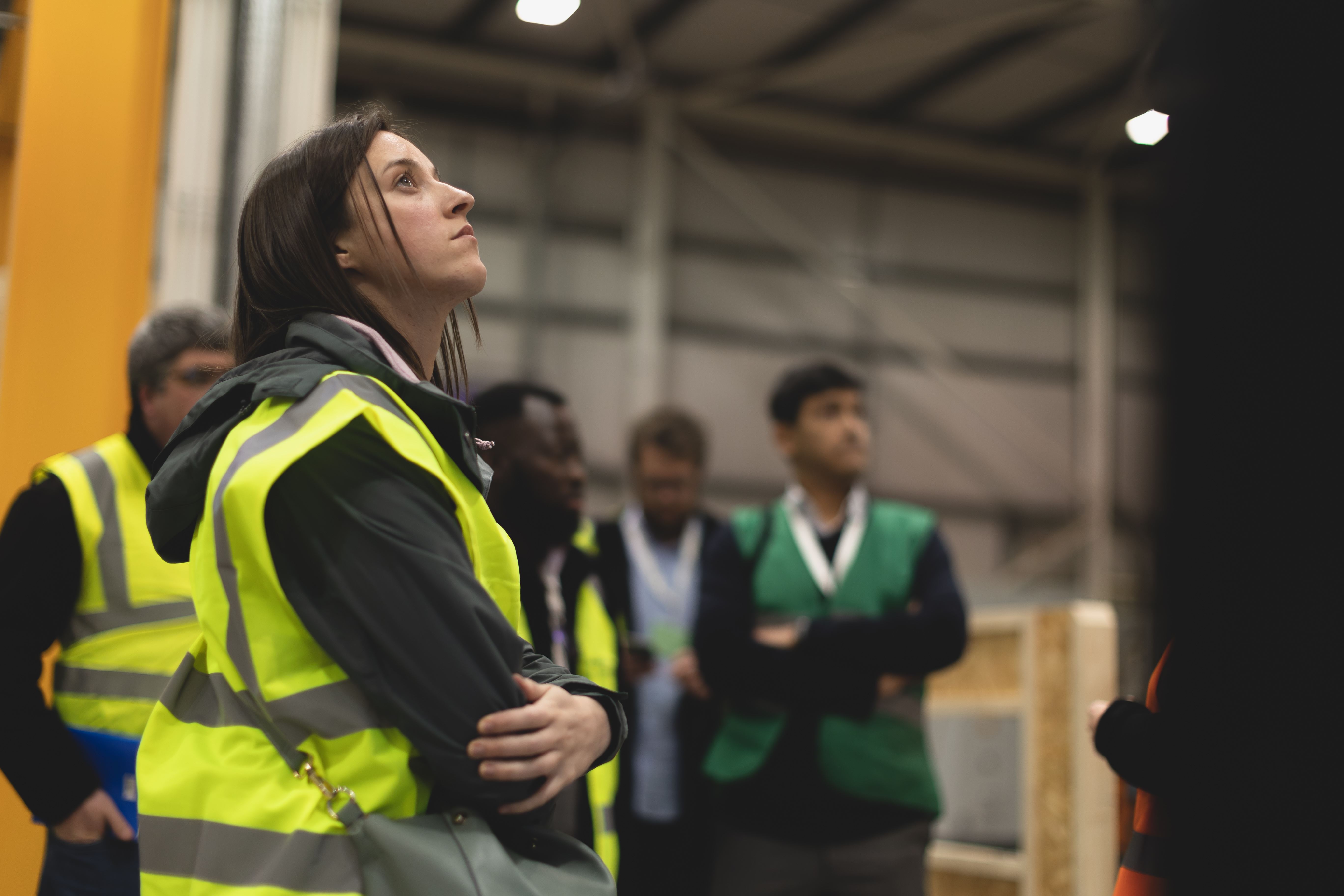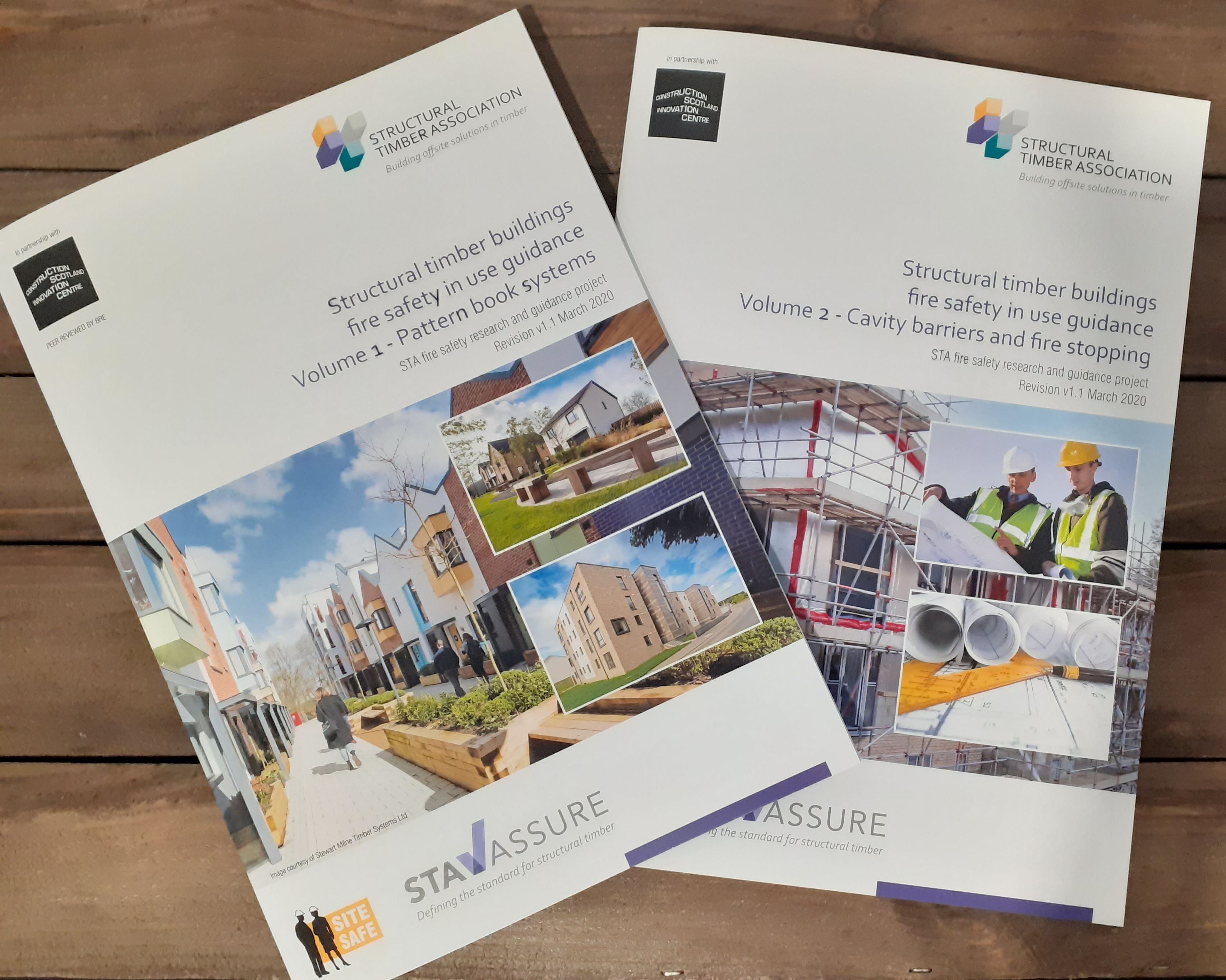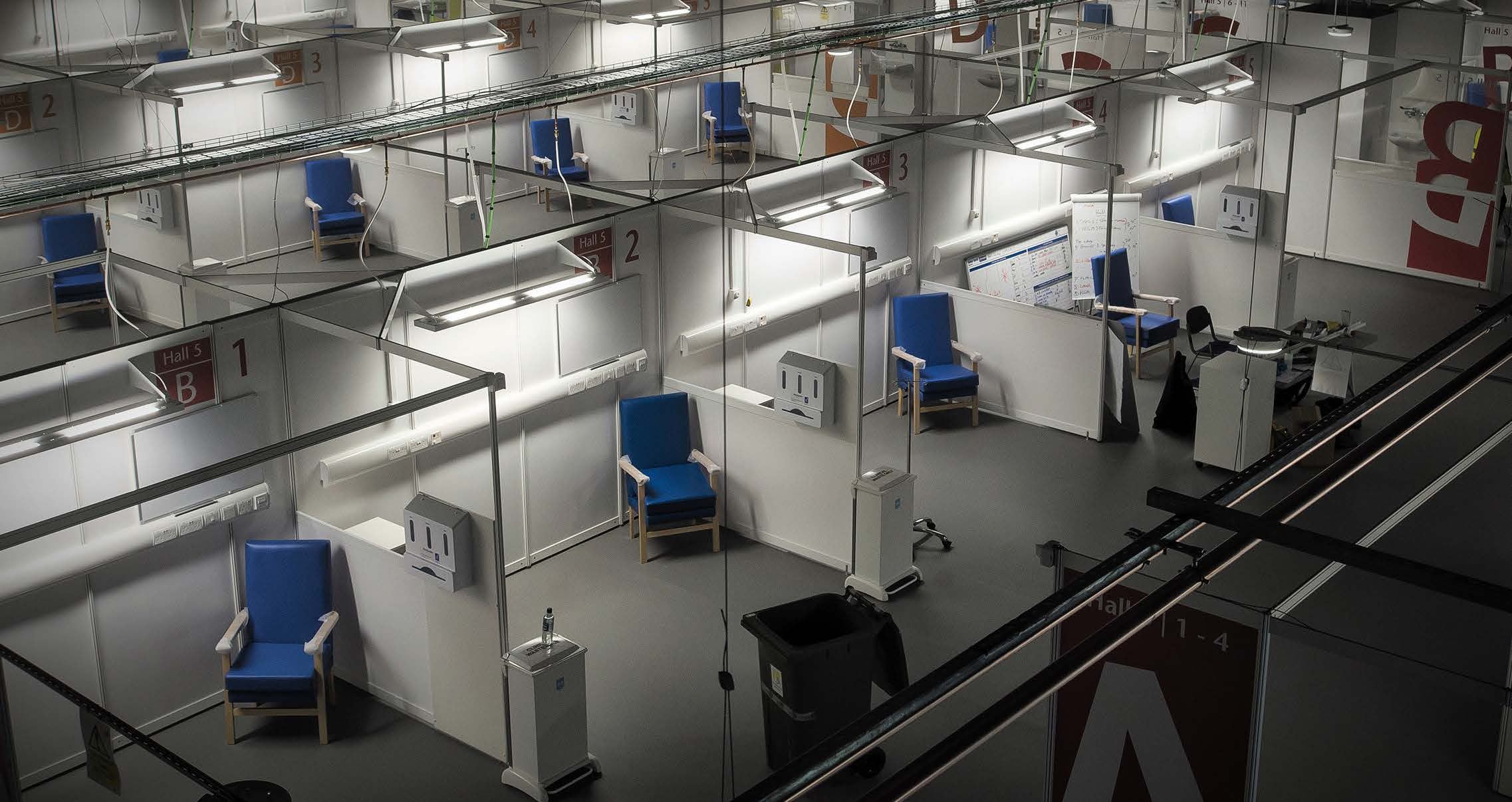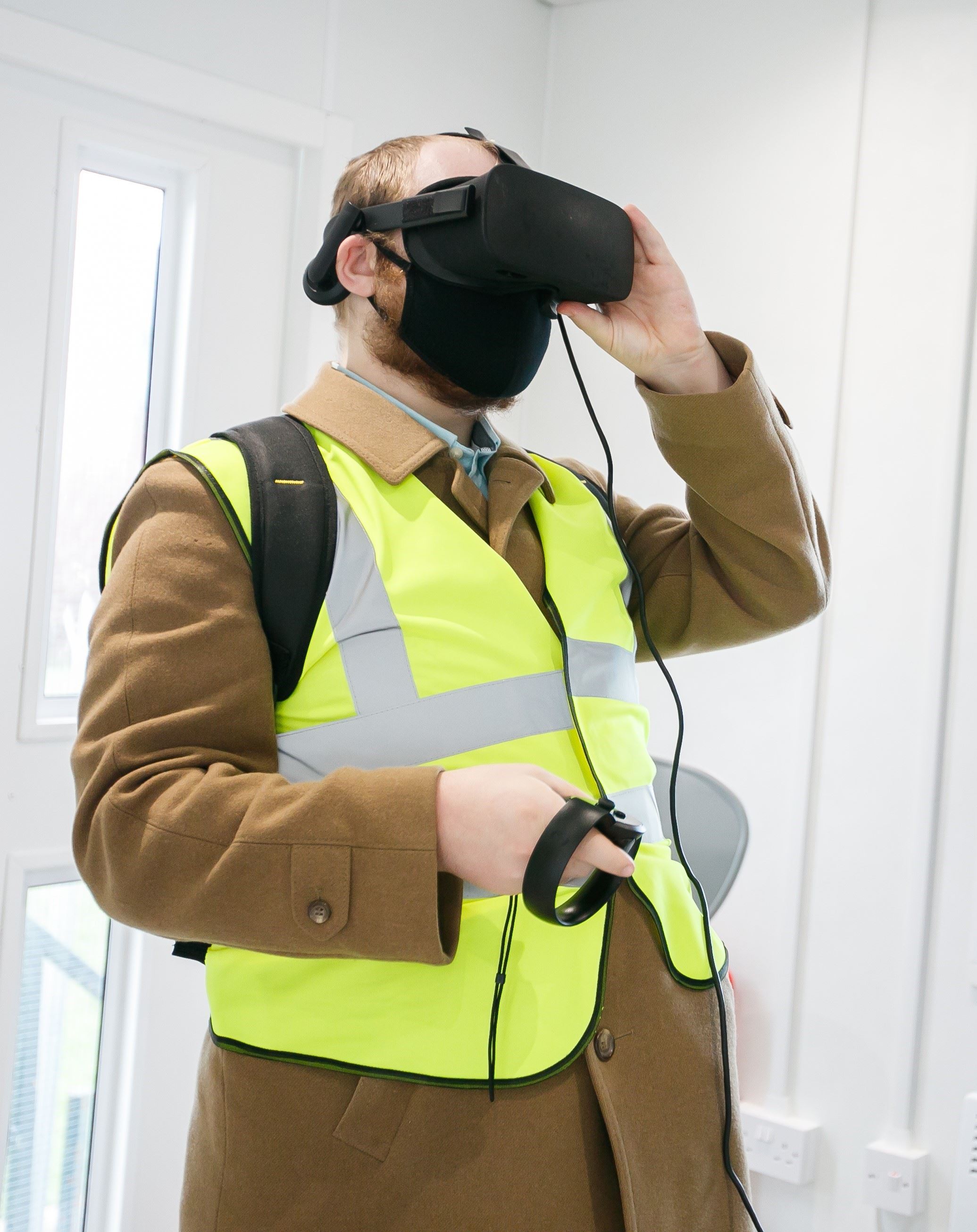Content
Masters' fund projects: 22-23
Case studies from the work our students do through the Built Environment Innovation Masters Fund.

Alice Davyson, MSc in Environmental Sustainability, Edinburgh Napier University
Project
Alice Davyson undertook a groundbreaking research project uncovering the hidden environmental impact of construction waste on embodied carbon in development projects. Her first-of-its-kind research on real on-site waste data found that a third of the total embodied carbon of a project can come from material wastage.
Innovation
Alice's project stands out for its innovative approach to addressing the massively underestimated issue of construction waste. Unlike traditional academic studies that rely on assumptions, Alice secured real on-site waste data through a collaboration with CALA Homes, a leading housebuilder. This methodology brought a level of precision and authenticity to the research, challenging existing norms in waste estimation.
The project's innovation extends to the detailed analysis of waste data. By examining the embodied carbon impact of construction waste, Alice introduced a novel perspective to the sector. This granular analysis provided insights into the true environmental consequences of construction waste, urging a re-evaluation of industry practices.
Furthermore, the research challenged assumptions prevalent in the construction sector, particularly the widely held belief that only 10% of site materials end up as waste. Alice's work highlighted the importance of questioning these assumptions and introduced a more realistic and data-driven approach to understanding construction waste.
Benefits
The impact of Alice Davyson's research reverberates across various dimensions, contributing to the advancement of sustainable practices in the built environment.
The research revealed that as much as one-third of the total embodied carbon in a construction project can be attributed to material wastage. This finding underscores the critical importance of addressing construction waste to achieve ambitious zero-carbon construction targets.
By bringing construction waste into sharp focus, Alice's research contributes to raising awareness within the construction industry. It exposes a significant gap in waste tracking practices and calls for a re-evaluation of industry standards and regulations to incorporate waste reduction strategies.
Alice's dedication and innovative research went onto earn her a class medal for her MSc in Environmental Sustainability at Edinburgh Napier University. This recognition showcases the educational benefits of pioneering research and highlights the potential for students to make substantial contributions to the field.
Partners
- Edinburgh Napier University
- CALA Homes
Anna Edovina, Spatial Planning with Sustainable Urban Design, University of Dundee
Project
Anna’s Master’s thesis investigated the intersection of heritage-led regeneration and environmental sustainability in post-industrial cities. Focusing on the Avenues Project in Glasgow and the Grey to Green project in Sheffield, the study offers a comparative analysis, bridging the gap between preserving historical urban landscapes and addressing modern environmental needs.
Innovation
The research uniquely brings together heritage preservation and environmental sustainability, providing fresh perspectives on urban planning. By scrutinising successful initiatives, the thesis is a practical guide for city revitalisation that prioritises both heritage and sustainability.
Benefits
The project benefits urban planners, stakeholders, and the wider Scottish construction market by offering pragmatic solutions for greener, more resilient city centres. The study's insights could serve as a blueprint for future urban development projects, leading to environmentally responsible and historically respectful urban spaces.
Partners:
- GreenBlue Urban
- University of Dundee
William Murray Cordiner, MSc in Spatial Planning with Sustainable Urban Design, University of Dundee
Project
William’s research addresses the challenges of implementing the "20-minute neighbourhood" concept in rural Angus, aligning with the Scottish Government's National Planning Framework 4 (NPF4). By examining the feasibility of repurposing disused rail networks, the study aims to foster connectivity, safe active travel, and biodiversity among rural communities.
Innovation
The research pioneers the exploration of the 20-minute neighbourhood concept within the specific context of rural communities, a novel approach compared to the predominant focus on urban environments. The study provides insights into the operationalisation of physical connectivity required to realise the Scottish Government’s vision of 20-minute neighbourhoods in rural areas.
Benefits
This project offers valuable insights for rural communities to operationalise the 20-minute neighbourhood concept, fostering more sustainable and connected communities. Angus Council stands to benefit from practical research applicable to their communities, while the Scottish construction market gains an economically viable option to align future rural developments with the NPF4 document, creating enhanced liveable spaces for community growth and prosperity.
Partners
- University of Dundee
- Angus Council
Bradley Dalziel, MSc Spatial Planning with Sustainable Urban Design, University of Dundee
Project
This research addresses the implications of the newly adopted National Planning Framework Four (NPF 4) on the Scottish Housing Market, specifically focusing on the issues of housing availability and affordability. The study critically examines the introduction of the Minimum All Tenure Housing Land Requirement (MATHLR) and its localised impacts, assesses the re-assessment of zoned housing land in existing local development plans, evaluates the deliverability of Policy 16 "Quality Homes," and explores the implications of the "Brownfield First Approach" on housing development site selection. Through literature review, analysis of NPF 4, and interviews with private and public sector organisations, the research aims to provide insights into the potential challenges and opportunities presented by NPF 4 in addressing the ongoing housing crisis in Scotland.
Innovation
This project is innovative as it directly engages with and examines the newly introduced NPF 4, offering critical insights into a policy that has yet to undergo extensive examination outside governmental processes. It addresses the timely and critical issue of housing availability, affordability, and choice, considering the economic conditions in Scotland. The research is valuable for the Scottish construction industry, providing insights into potential future conditions imposed by government and planning policy.
Benefits
The research provides context at the local level that can influence the drafting of Local Development Plans by authorities across Scotland in response to NPF 4. By examining current and future conditions in the context of newly introduced planning policies, the findings offer valuable insights that can shape the strategic approach of the wider Scottish construction market.
Partners
- University of Dundee
- Gray Planning & Development
Chloe McAdam, MSc Quantity Surveying, Glasgow Caledonian University
Project
Chloe’s research analysed the impact of newer sustainable building practices, particularly the Passivhaus construction standard, on embodied carbon and its implications for achieving net-zero goals. The growing popularity of Passivhaus in the UK prompted the researcher to investigate its role in supporting the government's net-zero objectives.
While the thermal benefits of Passivhaus are well-documented, debates exist regarding its potential effects on embodied carbon. The study seeks to address this gap and clarify the impact of the Passivhaus fabric-first approach on a building's embodied carbon.
Innovation
This project stands out as it shifts the focus from operational carbon to embodied carbon, providing crucial insights for the industry's transition to low carbon. By conducting a comprehensive life cycle assessment comparing Passivhaus and traditional construction, the research contributes novel information to the global discourse on sustainable building practices. This shift in focus is innovative and relevant to meeting legal obligations for greenhouse gas emission reduction.
Benefits
The project's findings will offer valuable information for the wider Scottish construction market, especially as Passivhaus gains popularity in public sector projects.
By highlighting the benefits and potential challenges associated with Passivhaus in terms of embodied carbon, the research contributes to informed decision-making, ensuring that the industry aligns with funding requirements and supports Scotland's efforts to reduce energy emissions.
Partners
- Morrison Construction
- Glasgow Caledonian University
Jack Connell, MSc Environmental Management, Glasgow Caledonian University
Project
The project focuses on exploring opportunities for decarbonising the Built Environment, with a special emphasis on the residential buildings managed by Sandstone UK. The project delves into key aspects such as government policies, building materials, Passivhaus Standards, retrofitting strategies, and modular housing. In the research, Sandstone UK acts as a case study company in evaluating practical opportunities for decarbonisation.
Innovation
The project introduces innovative concepts such as the K-Briq, an eco-efficient Brick alternative, and explores the sustainable principles of Passivhaus Standards. It also delves into the strategic concept of retrofitting and examines the efficiency of modular construction. The exploration of these concepts provides a fresh perspective on sustainable construction practices, offering potential solutions for the built environment.
Benefits
The benefits derived from this project are manifold. The comprehensive literature review provides depth and leverage to the overall discussion, offering insights into the current state of the housing market in Scotland, the impact of government policies, and the potential of various building materials. The inclusion of case studies, especially that of Sandstone UK, offers practical insights into the challenges and opportunities for decarbonisation. The structured interviews with industry professionals contribute valuable data, highlighting the recognition of sustainable construction while revealing barriers, particularly economic factors, hindering a swift transition. The project, although facing challenges, presents valuable findings that contribute to the ongoing discourse on achieving a decarbonised built environment.
Partners
- Glasgow Caledonian University
- Sandstone property UK
Jennifer Dunn, MSc Spatial Planning and Sustainable Urban Design, University of Dundee
Project
Jennifer's research investigates how people's perceptions of pedestrian routes between their homes and urban green spaces affect how they use these spaces. Motivated by a 2021 study on women's safety in Queen Elizabeth Olympic Park, London, the project identifies a gap in the conversation about the equitable provision of urban green space, focusing on the surrounding areas and neighbourhoods. The main research methods include a photovoice survey, walking interviews with Edinburgh South residents, and interviews with London Legacy Development Corporation (LLDC) staff.
Innovation
The project is innovative in its focus on the experiential aspect of accessing urban green spaces, challenging the conventional metrics of distance and area per capita. While government guidelines often prioritise proximity to green spaces, the project highlights the importance of considering people's feelings and experiences along the pedestrian routes to these spaces. This holistic approach offers a new perspective on urban planning, which can extend to other services supporting well-being in urban environments such as schools, supermarkets, and community centres.
Benefits
The project by Jennifer provides insight into the interconnectedness of different aspects of the built environment. By exploring how pedestrian routes impact the use of green spaces, the research contributes to a more comprehensive understanding of accessibility planning. The findings have broader implications for the provision of services aimed at improving quality of life in urban areas. While the immediate focus is on green spaces, the project's principles can be applied to various services, offering a valuable perspective for urban planning and construction practices in Scotland and beyond.
Partners
- Slow Ways
- University of Dundee
Jesulonimi Sodeinde , Postgraduate Diploma in Housing Studies, University of Stirling
Project
Jesulonimi focused on a review of Ochil View Housing Association's (OVHA) reactive maintenance policy in her research, aiming to incorporate the opinions of their tenants. The study involves engaging with a Tenant Scrutiny Group and conducting an online survey to gather insights on tenant satisfaction, dissatisfaction, and recommendations for improvements in the current repair processes. The project utilises monthly meetings with the Tenant Scrutiny Group and an online survey to analyse what is working well, where improvements are needed, and to align the policy with tenants' perspectives.
Innovation
The innovation lies in its approach to tenant engagement and the direct inclusion of their opinions in shaping the reactive maintenance policy. By prioritising tenants' voices, the research ensures that policy changes reflect their concerns and needs rather than being solely driven by management decisions. This emphasis on tenant involvement sets an example for the sector, demonstrating the positive outcomes that can arise from exploring issues directly with tenants. The project's approach could inspire better processes and contribute to the advancement of industry practices in the Scottish construction market.
Benefits
Jesulonimi’s project benefits OVHA tenants by actively involving them in the policy review process, allowing them to impact the outcome positively. The engagement model ensures that tenants' opinions are considered at all stages, fostering a sense of ownership and satisfaction. Furthermore, the project's outcomes may lead to a policy review by the Board or Committee, potentially serving as a benchmark for other housing associations. The ripple effect of improved policies influenced by tenant engagement can contribute to better practices and standards across the wider Scottish construction market.
Partners
- University of Dundee
- Ochil View Housing Association
Matthew Young, MSc Environmental Management, University of Stirling
Project
Matthew’s research focuses on assessing the feasibility of incorporating nuclear fusion, specifically Magnetic Confinement Fusion (MCF) and Inertial Confinement Fusion (ICF), into the USA's net-zero emissions plans by 2050. The project delves into the engineering challenges of both fusion technologies, examines ongoing and planned projects, and compares their potential contributions to a net-zero economy. The study aims to determine the competitiveness of these fusion technologies compared to renewable energy sources, with a focus on understanding the differences and convergences in their engineering challenges.
Innovation
The project's innovation lies in its comprehensive exploration of two distinct fusion technologies and their engineering challenges. While Scotland is not presently home to experimental fusion sites, the research considers the potential for Scotland to host such sites in the future. The project contributes to shaping the direction of Scotland's energy landscape, especially considering its significant reliance on renewables. By examining how fusion technologies may compete in the 2050 energy market, the research provides insights into the potential roles of fusion in the global and Scottish construction industry.
Benefits
The project offers the potential benefit of fusion as a stable and clean energy source, acting as a replacement for fossil fuels and complementing existing renewable energy infrastructure. While Scotland heavily relies on renewables, the research explores the scalability and reliability of fusion technologies, highlighting their potential competitiveness in the future energy market. Fusion's role as a replacement for fission plants, without radiation risks, could ensure a consistent grid without the need for extensive energy storage infrastructure. The findings may contribute to Scotland's energy planning and have broader implications for the global construction industry's future energy choices.
Partners
- University of Stirling
- Edinburgh City Council
Mr Remzi Aydin, MSc Housing Studies, University of Stirling
Project
This research focuses on understanding the impact of mould pollution on social housing tenants managed by the City of Edinburgh Council, which oversees a substantial housing portfolio. The study employs qualitative interviews with housing managers and tenants to uncover challenges associated with mould pollution, such as communication barriers and a lack of awareness about effective housekeeping practices. The research proposes the innovative use of environmental sensors for early detection of mould, presenting a proactive solution to enhance tenant well-being and the overall health and sustainability of the built environment.
Innovation
From a technical perspective, the project introduces a paradigm shift by advocating for the use of environmental sensors to proactively monitor indoor air quality and manage mould prevention. This data-driven approach represents a novel and groundbreaking solution in the housing sector, offering a preventative measure rather than a reactive one. The innovative use of sensors has the potential to transform how housing authorities, including the City of Edinburgh Council, address mould pollution, contributing to healthier living environments.
From a commercial standpoint, the project's emphasis on environmental sensors presents a cost-effective solution, alleviating the financial burden on housing authorities associated with costly repairs and inspections. The research aligns with sustainability objectives, making it an attractive option for the City of Edinburgh Council and the broader construction industry. The focus on sustainable practices and creating healthy living environments enhances the project's market appeal, addressing a widespread issue with broader market potential.
Benefits
The project provides the City of Edinburgh Council with fresh insights and a novel perspective on addressing mould pollution, contributing to their sustainable housing regeneration goals. By leveraging environmental sensors for early detection, the research actively supports the council's commitment to sustainability, enhancing its reputation in sustainable development initiatives. The benefits extend beyond the City of Edinburgh Council, potentially influencing other housing authorities and construction companies to adopt similar proactive measures. Ultimately, the project aims to prevent tragedies like the one involving a two-year-old boy's death due to mould exposure, emphasising the urgency and relevance of this innovative approach in the broader Scottish construction market and beyond.
Partners
- The City of Edinburgh Council
- University of Stirling
Sarah Carlyle, Spatial Planning with Sustainable Urban Design, University of Dundee
Project
This research focuses on the implementation of the 20-minute Neighbourhood (20MN) or Local Living (LL) concept in the rural context of selected Angus towns and villages in Scotland. Driven by the Scottish National Planning Framework 4 (NPF4) and Policy 15, the study aims to assess the current baseline using the Place Principle approach, understand community perspectives, perform a comparative analysis, and determine effective methods for applying the 20MN/LL concept within rural settlements. The insights gained will contribute to Angus Council's Local Development Plan.
Innovation
The innovation lies in addressing the challenge of integrating the 20MN/LL concept into rural areas, a unique consideration compared to its more common application in urban settings. The research adopts a pioneering approach by actively engaging with local community groups and residents to understand the distinct characteristics, opportunities, and challenges of Angus' rural towns and villages. This community-driven perspective ensures the development of solutions that are sensitive to the needs and aspirations of the rural population.
Benefits
The project's outcomes will provide valuable insights for the Scottish construction market and decision-makers. By addressing the challenges and opportunities of implementing the 20MN/LL concept in rural areas, the research contributes to a more sustainable approach to planning and development. The lessons learned, along with the data gathered, will inform future decisions in mass house building, service provision, and other essential principles of 20-minute neighbourhoods. This research aligns with the contemporary emphasis on local living and sustainable development, offering a blueprint for transformative approaches in both rural and suburban contexts, benefitting the wider Scottish construction market.
Partners
- Angus Council
- University of Dundee
Shirley Scott, Postgraduate Diploma in Housing Studies, University of Stirling
Project
Shirley’s research investigates the impact of time spent in temporary supported accommodation on future tenancy sustainment outcomes, especially for individuals with additional support needs. The study adopts a mixed-methods approach, combining longitudinal data covering a 5-year period (2018-2023) from Falkirk Council and exit interviews with tenants who stayed in temporary supported accommodation facilities between April 2022-March 2023.
Innovation
Several innovative aspects distinguish this project. The mixed methods design, incorporating both quantitative and qualitative data, offers a comprehensive understanding of the factors influencing tenancy sustainment. Temporary supported accommodation, a critical component of the homelessness response system, is often overlooked in research. This study addresses this gap, shedding light on its potential contribution to tenancy sustainment outcomes. By focusing on the future, the research considers the long-term impact of temporary supported accommodation on preventing repeat homelessness.
Benefits
Shirley's findings will provide evidence on whether temporary supported accommodation contributes to improved tenancy outcomes for individuals with additional support needs. This insight is crucial for local authorities relying on such facilities for short-term housing solutions. The evidence collected over a 5-year period will offer a comprehensive understanding of the relationship between temporary supported accommodation and tenancy sustainment. The benefits extend beyond the immediate research scope, influencing policy and practices in addressing homelessness and enhancing tenancy outcomes. While the direct impact on the Scottish construction market may be indirect, the project's outcomes contribute to more informed decision-making in the housing sector, potentially influencing construction practices aligned with the needs of individuals in temporary supported accommodation.
Partners
- Falkirk Council
- University of Stirling



